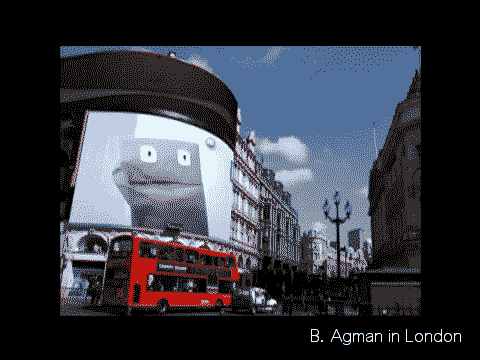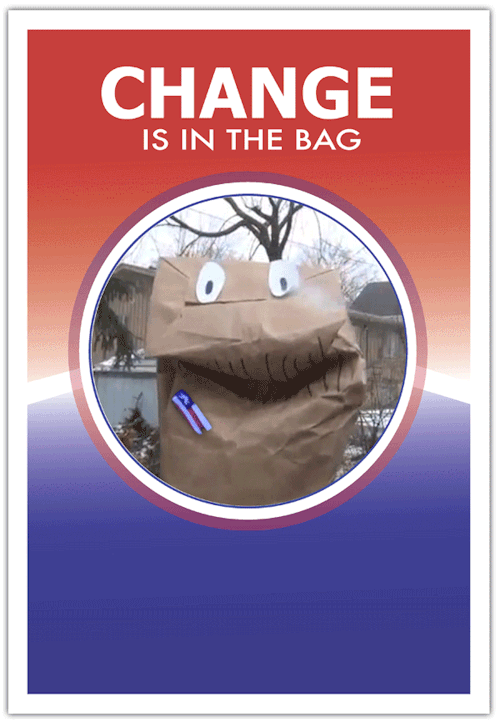-
A morning in the garden pottering with various apps. I guess I should have been gardening instead. The toad not mine but from Flickr cc by. He fitted in too well here not to add!
-
Meaningful Online Relationships
I’ve been wanting to write this post for a while. It’s about the possibilities and potential of meaningful online relationships. It’s been sort of building up and is about to explode after two articles (followed by facebook discussions, mostly on rhizo14) … Continue reading →
-
Mid-March Garden
A mid-March update on the Garden 2014 project at Chickadeeacres!
-
The importance of history – advise to new students One of the…



The importance of history - advise to new students
One of the things I most value about being part of the DS106 community is that it makes come alive years of theory and research on the creative process.
On this post I want to talk about Bagman, a character that is part of the DS106 oral tradition and how it relates to a systemic theory of creativity.
I started the week looking for a photo of ‘the little paper bag character’ I had seen on Twitter some time ago. I thought it was created by Martha Burtis but soon found out that it was Brian Short’s original idea, that it was called Bagman and that he had ran for president in the past with a comprehensive campaign being staged by past DS106 participants. He has become an assignment on the DS106 bank.
His most recent appearance was to claim his own domain at UMW, a trailer well worth watching. Search for him on the google and there are pages of fun art to listen to and watch, all to do with this little paper bag creation.
Why bother writing about him? Other than the obvious prima facie reason that he is awesome, there are those out there who need a rationale for having fun, if that is not too much of an oxymoron. Sheep! I needed a rationale to join this cult #4life not too long ago.
So let me be serious for a minute and bring to bear my academic expertise as the DS106 Shrink to the important subject that is Bagman or B. Agman as I believe he is known on Linkedin. The dry and boring diagram on photo set above, explain systemic creativity. I put it here for completeness but will only focus on what is relevant to this story.
As I was digging into the history of DS106 through finding out about this little character, I had a lived experience of what Csikszentmihalyi (the guy responsible for boring diagram) means when he says that we need to ask where is creativity? Rather than, What is creativity?
In psychology often the focus is on the person and how to develop individual creativity. Until I came across this model I used to focus all my workshops on individual creativity too. But the individual is not an island and in order for creative output to obtain, we need to look beyond the ‘I’. The individual belongs to a field or craft. In that field there are colleagues, journals and review processes that determine what becomes part of the domain of that field. The acceptance of a given output by the field into the domain determines what future students learn as the symbol system for that field that they can then deviate from - the symbols they will manipulate to become creators. A key thing the theory proposes and one that is often forgotten by those who want to encourage creativity is the need of years of training and practicing to learn that symbol system - in other words you will not become Einstein without learning physics.
This is similar to what Ira Glass says about practicing your craft. You will suck for a long time as you learn your craft, what you do will not be accepted in the field and even if your taste is impeccable all the way through your output will not match your taste. Do read Alan Levine’s latest post to understand more about this and learn a lot about what teaching means within our little DS106 community.
What does all this have to do with Bagman?
I have always struggled to explain this theory to my students. It seems self evident to me, but not often to others on first seeing it. I can now explain it with Bagman. Tracking his story this morning taught me a little more about the people who ‘are’ DS106 today, this will help me join the conversation. It is always tough to come into a party where you don’t know anyone; knowing their war stories, their recurrent jokes and developing an ability to contribute to their interactional currency will help you join in. In some ways, all we have online is this narrative history to establish relationships within an existing social system.
If you are coming in new to DS106 it would pay you to study it narrative history or as I think of it, its oral tradition.
The open web is a great repository of this tradition as many students before you have engaged with the course and produced creative outputs for it. DS106 has a symbol system and it is not so obvious without studying a little history.
The characters and the creations of the students involving each character were the medium through which students became part of the social system that is the field of DS106. If you look at the content only (the tools, the assignments, the weekly announcements) you will miss a core element of what makes this community special. The way to be accepted within it is also by knowing its history through narrative. You can then locate individuals and their roles within the community through the history they share.
The big difference between being a DS106 student and being a physicist is of course that neither the social nor the symbol system through which people interact is made explicit when you join it. You have to dig for it, and realise that it matters. It matters not because Bagman will change your world or teach you digital storytelling techniques (although he might), it matters because it is a history that the community shares and often talks about.
I am also very aware in making artefacts that there is a difference between making things for the DS106 community, with the intention of engagement and interaction and making things for a wider social system. Much of what I make within this community is pretty meaningless to those outside it or new to it. From an individual creativity perspective I am practising digital storytelling whatever the content. If that is your intention in joining the social and symbol systems may be do not matter.
Yet, seeing DS106 as a domain of knowledge in itself with a symbol system embedded in its oral tradition, its content maintained informally by the social system interacting around these symbols, may enable new open participants to participate more fully in the learning process.
And we are all pretty vain, so we love to be asked about what we have made and why we have made it! If you are joining us on March 18th for the first time, welcome to the party.
Campaign gif source; http://blog.neverthesameriver.com/change-its-in-the-bag-design-assignment/
Video for Bagman in London gif: http://youtu.be/mdxolXh3U60
-
The Journey
"You strode deeper and deeper into the world determined to do the only thing you could do—"
-
OERs, MOOCs, and dieting
This is just a quick post re-capping thoughts from today’s twitter discussions and especially the #nwoerchat First, I want to point out that I remembered Rebecca Hogue’s great work on a framework for describing MOOCs and was compelled to share … Continue reading →
-
Give me an OER every time!
WOW! The highlight of open education week for me undoubtably was Jisc Digifest 2014. It was so packed with festival goodies that it was difficult to chose which sessions to attend, and then what highlights to write about. So here … Continue reading → -
Missed Star
"And following the wrong god home we may miss our star..."
-
How many shades of open?
It occurs to me that those of us advocating for open access in academia (whether open educational resources OER or open access publishing) have a really hard time. We’re passionate about something, believe in it so much, it seems instinctual: … Continue reading →
-
Writing ourselves into history; righting history (inspired by @Mark_Mcguire & #write4pro)
I started my day by this incredible tweet by my twitter-buddy Mark McGuire. I loved it so much I kept going back to it several times during the day just to get inspired again: .@KateMfD To write in public is … Continue reading →
-
Roll up. Roll up. Get your free study skills OERs here.
Happy Open Education Week! Open education philosophies and approaches - resources, courses, practices – are well embedded into educational thinking around the globe. Here is just one example of how awesome open education can be, and how completely awesome the global community … Continue reading → -
Privacy and openness
One of the things I like about the topics in The Internet Course is that they can be interpreted pretty broadly. This week we’re looking at privacy and openness. They can be seen as in opposition to each other, or … Continue reading → -
Dawson Park
Yesterday we discovered Dawson Park, another of Edmonton’s beautiful riverside parks. The girls loved exploring the hoodoos. We could see evidence of the Mazama Volcanic eruption in Oregon 7,000 years ago in the exposed cliffs. We have a a few more parks to explore.
The post Dawson Park appeared first on Rhonda Jessen.com.
-
My Overdue Sunshine Post
Over the Christmas holidays I was given a Sunshine Blog Challenge Tanis Theissen and Julie Balen. I had a few too many things on my plate at the time to accept the challenge but life has slowed down a little bit and I have finally had a chance to reply. Sorry it has taken me […]
The post My Overdue Sunshine Post appeared first on Rhonda Jessen.com.
-
-
Slice of Life: Blowing the Dust off the XO Netbook
(This is part of the Slice of Life Challenge with Two Writing Teachers. We write about small moments each and every day for March. You come, too. Write with us.) I was going going through my classroom closet the other day. You might have a space like that, too, where years of curriculum and resources […] -
Gif Scraping and a DS106 Gif API
It started, as so many things do, with a tweet(bark?) from CogDog linking to The Best of ds106 GIF TV. This got me thinking of how to automate the gathering of gifs. I remembered that I had done some gif scraping a while back: Doug’s Gifs. I wondered about scrapping tumblr in the same manner […] -
Oh! Sheep. I am addicted to fast cut animated gifs. Creating my…
Oh! Sheep. I am addicted to fast cut animated gifs. Creating my own colour palettes now. I am such an artiste! -
Orca Mystery
I feel I am in the presence of mystery, of trying to understand something just beyond my reach.
-
My Selfie with Ellen and The Gang
You probably saw the picture on Twitter that was taken just AFTER this one. The other one looks almost the same as this one, except I had already gone back to my seat after Meryl Streep put me back down on the floor after she lifted me up into the shot. She could be a True […] -
GIFaDog Is Honored
Our resident GIFaDog , Colin (@GIFaDog), has been in the spotlight of late. He was recently awarded a Certificate of Excellence from the Institute of Barkology. Thanks go out to the head of our communications department,... -
GIFing with Jean-Claude
My latest round of creativity induced OCD started with a new GIFFight challenge from Michael B Smith (@mbransons) New #GIFFIGHT!!! #JCVD style. http://t.co/j0c0ibFD0Q @ryanseslow @abelincolnjr @generalhowe @twoodwar @johnjohnston — Michael B Smith (@mbransons) March 1, 2014 There’s also a DS106 Animated GIF Assignment 1190 for any of the GIFFight projects to post to. After downloading […] -
On Pedagogical Peer Review & @hybridped
I have been wanting to write my views about open peer review for a while, but thought to wait until i experienced it firsthand. I just did – my first (co-authored) article on my favorite journal Hybrid pedagogy has just … Continue reading →
-
OSS
Open source software came up in the discussion of intellectual property and fair use in The Internet Course. I wasn’t really expecting it to come up at that point, but I was planning on bringing it into the discussion of … Continue reading → -
Photo Maintenance
I’ve been catching up on my daily photo project. Not the photos, of course, but the archives. I’ve updated the week of photos on my main Photo page for the first time in a while. I’ve started a page for my Daily Photos for 2014, and made pages for January and February‘s photos. I’ve updated […]
The post Photo Maintenance appeared first on Rhonda Jessen.com.
-
Faster, Faster, Gif, Gif
I’ve been having quite a lot of fun with animated gifs recently. Mariana Funes @mdvfunes posted a method developed by Michael B Smith for making gifs from fast cut bit of video. Mariana’s post: The Altered State Gif Technique gives the details. I’ve been doing some experimenting around this. First I just googled fast cut […] -
Join in as DS106 Goes to Work
If you have been looking for a DS106 experience to join, your boat comes in March 18. That is when an online course I have been invited to teach in DS106 style starts. EDIT 572: Digital Audio/Video Design and Applications is part of a graduate certificate Instructional Design and Technology (IDT) Program at George Mason University. Last summer Nada Dabbagh asked me if I could teach this course with a storytelling approach, even bringing the ds106 mode to it. “Are you sure?” I asked. This class will be 7 weeks long, and is two credits, so I have been paring back a bit of what I typically do in the UMW courses (see the general syllabus). What’s different for this course is that the students are all working employees of a major consulting firm, working on the IDT program at GMU. They have been described to me as “road warriors” […] -
Gender Issues in Teaching Physics?
I recently signed up for the MOOC for physics educators that Dave Cormier is collaborating on with Piotr Mitros on EdX. One of the first things we were invited to do is share our goals for participating, and mine are … Continue reading →
-
Storytelling 101: Symptomatic for the People
I totally wrote this whole entire post about one of the chapters of Wired for Story, analyzing whether a particular bit of advice was useful or not (it very much … Continue reading →
-
Barkology. The origins.
From Bachology to Barkology. Barking Certificate by Christina Hendricks. I loved Christina’s Daily Create today because it referred to the Institute of Barkology. It is a little known fact that the … Continue reading →

